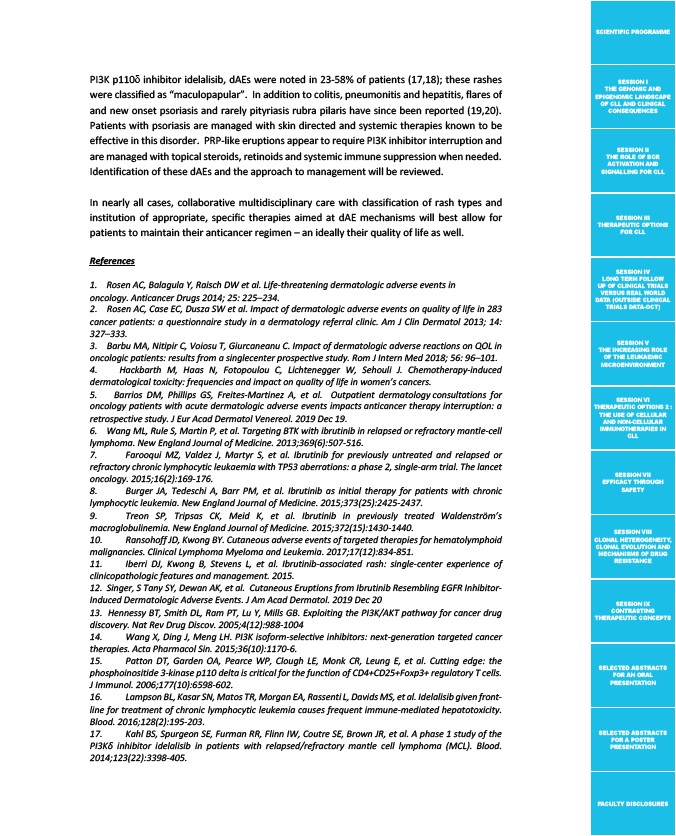
SCIENTIFIC PROGRAMME
SESSION I
THE GENOMIC AND
EPIGENOMIC LANDSCAPE
OF CLL AND CLINICAL
CONSEQUENCES
SESSION II
THE ROLE OF BCR
ACTIVATION AND
SIGNALLING FOR CLL
SESSION III
THERAPEUTIC OPTIONS
FOR CLL
SESSION IV
LONG TERM FOLLOW
UP OF CLINICAL TRIALS
VERSUS REAL WORLD
DATA (OUTSIDE CLINICAL
TRIALS DATA-OCT)
SESSION V
THE INCREASING ROLE
OF THE LEUKAEMIC
MICROENVIRONMENT
SESSION VI
THERAPEUTIC OPTIONS 2 :
THE USE OF CELLULAR
AND NON-CELLULAR
IMMUNOTHERAPIES IN
CLL
SESSION VII
EFFICACY THROUGH
SAFETY
SESSION VIII
CLONAL HETEROGENEITY,
CLONAL EVOLUTION AND
MECHANISMS OF DRUG
RESISTANCE
SESSION IX
CONTRASTING
THERAPEUTIC CONCEPTS
SELECTED ABSTRACTS
FOR AN ORAL
PRESENTATION
SELECTED ABSTRACTS
FOR A POSTER
PRESENTATION
FACULTY DISCLOSURES
PI3K p110d inhibitor idelalisib, dAEs were noted in 23-58% of patients (17,18); these rashes
were classified as “maculopapular”. In addition to colitis, pneumonitis and hepatitis, flares of
and new onset psoriasis and rarely pityriasis rubra pilaris have since been reported (19,20).
Patients with psoriasis are managed with skin directed and systemic therapies known to be
effective in this disorder. PRP-like eruptions appear to require PI3K inhibitor interruption and
are managed with topical steroids, retinoids and systemic immune suppression when needed.
Identification of these dAEs and the approach to management will be reviewed.
In nearly all cases, collaborative multidisciplinary care with classification of rash types and
institution of appropriate, specific therapies aimed at dAE mechanisms will best allow for
patients to maintain their anticancer regimen – an ideally their quality of life as well.
References
1. Rosen AC, Balagula Y, Raisch DW et al. Life-threatening dermatologic adverse events in
oncology. Anticancer Drugs 2014; 25: 225–234.
2. Rosen AC, Case EC, Dusza SW et al. Impact of dermatologic adverse events on quality of life in 283
cancer patients: a questionnaire study in a dermatology referral clinic. Am J Clin Dermatol 2013; 14:
327–333.
3. Barbu MA, Nitipir C, Voiosu T, Giurcaneanu C. Impact of dermatologic adverse reactions on QOL in
oncologic patients: results from a singlecenter prospective study. Rom J Intern Med 2018; 56: 96–101.
4. Hackbarth M, Haas N, Fotopoulou C, Lichtenegger W, Sehouli J. Chemotherapy-induced
dermatological toxicity: frequencies and impact on quality of life in women’s cancers.
5. Barrios DM, Phillips GS, Freites-Martinez A, et al. Outpatient dermatology consultations for
oncology patients with acute dermatologic adverse events impacts anticancer therapy interruption: a
retrospective study. J Eur Acad Dermatol Venereol. 2019 Dec 19.
6. Wang ML, Rule S, Martin P, et al. Targeting BTK with ibrutinib in relapsed or refractory mantle-cell
lymphoma. New England Journal of Medicine. 2013;369(6):507-516.
7. Farooqui MZ, Valdez J, Martyr S, et al. Ibrutinib for previously untreated and relapsed or
refractory chronic lymphocytic leukaemia with TP53 aberrations: a phase 2, single-arm trial. The lancet
oncology. 2015;16(2):169-176.
8. Burger JA, Tedeschi A, Barr PM, et al. Ibrutinib as initial therapy for patients with chronic
lymphocytic leukemia. New England Journal of Medicine. 2015;373(25):2425-2437.
9. Treon SP, Tripsas CK, Meid K, et al. Ibrutinib in previously treated Waldenström’s
macroglobulinemia. New England Journal of Medicine. 2015;372(15):1430-1440.
10. Ransohoff JD, Kwong BY. Cutaneous adverse events of targeted therapies for hematolymphoid
malignancies. Clinical Lymphoma Myeloma and Leukemia. 2017;17(12):834-851.
11. Iberri DJ, Kwong B, Stevens L, et al. Ibrutinib-associated rash: single-center experience of
clinicopathologic features and management. 2015.
12. Singer, S Tany SY, Dewan AK, et al. Cutaneous Eruptions from Ibrutinib Resembling EGFR Inhibitor-
Induced Dermatologic Adverse Events. J Am Acad Dermatol. 2019 Dec 20
13. Hennessy BT, Smith DL, Ram PT, Lu Y, Mills GB. Exploiting the PI3K/AKT pathway for cancer drug
discovery. Nat Rev Drug Discov. 2005;4(12):988-1004
14. Wang X, Ding J, Meng LH. PI3K isoform-selective inhibitors: next-generation targeted cancer
therapies. Acta Pharmacol Sin. 2015;36(10):1170-6.
15. Patton DT, Garden OA, Pearce WP, Clough LE, Monk CR, Leung E, et al. Cutting edge: the
phosphoinositide 3-kinase p110 delta is critical for the function of CD4+CD25+Foxp3+ regulatory T cells.
J Immunol. 2006;177(10):6598-602.
16. Lampson BL, Kasar SN, Matos TR, Morgan EA, Rassenti L, Davids MS, et al. Idelalisib given front-line
for treatment of chronic lymphocytic leukemia causes frequent immune-mediated hepatotoxicity.
Blood. 2016;128(2):195-203.
17. Kahl BS, Spurgeon SE, Furman RR, Flinn IW, Coutre SE, Brown JR, et al. A phase 1 study of the
PI3Kδ inhibitor idelalisib in patients with relapsed/refractory mantle cell lymphoma (MCL). Blood.
2014;123(22):3398-405.